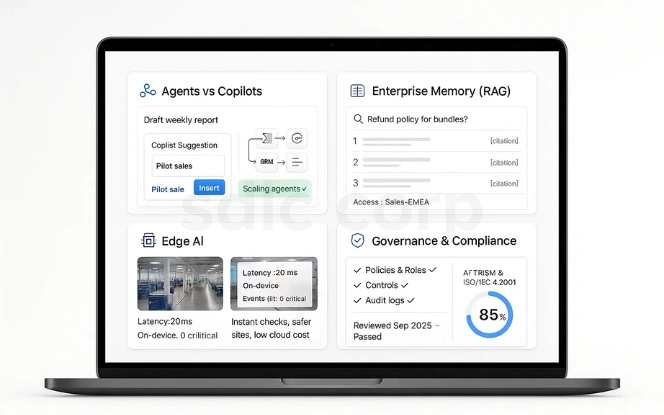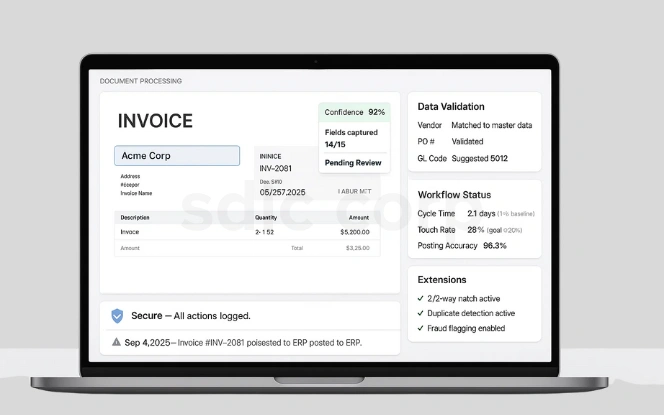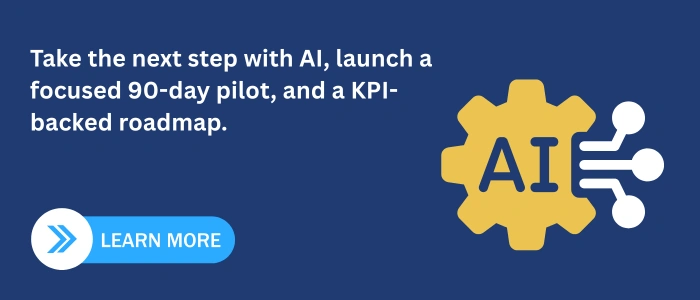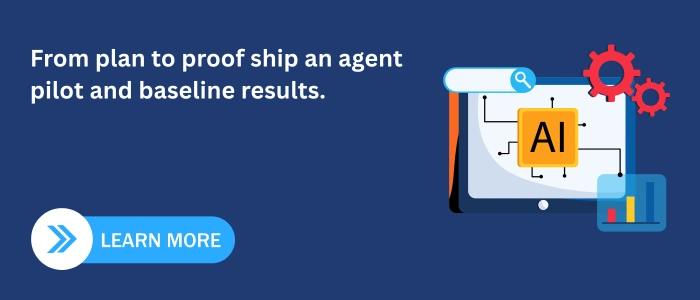Introduction
From 2025 to 2028, AI will move from pilots to profit. Winners pick a few AI services for business, plug them into daily work, and measure real outcomes. This guide covers seven priorities with clear steps, examples, and a roadmap so you avoid false starts.
If your team lacks bandwidth or depth in data and governance, consider partnering with an experienced AI development company. A good partner accelerates data readiness, sets guardrails, designs small pilots, and handles integrations so value shows up sooner.
Core AI Development for Business Systems
AI-driven transformation depends on reliable system design, secure integrations, and scalable infrastructure. Many organisations rely on structured AI development services to embed AI features into existing enterprise software and digital platforms.
Key Concepts

- Agents vs Copilots: Copilots assist people inside tools; agents pursue goals across systems with guardrails. Most teams start with copilots to learn safely, then move to narrow agents where volumes are high.
- RAG (enterprise memory): Retrieval-augmented generation grounds answers in your content with citations and permissions. It reduces errors, speeds onboarding, and keeps answers consistent.
- Edge AI: Running models near where data is created unlocks instant checks, safer sites, and lower cloud egress costs. This is great for vision, safety, and low-latency tasks.
- AI TRiSM & ISO/IEC 42001: Use governance frameworks to define policy, roles, controls, monitoring, and audits. Governance speeds approvals and reduces surprises.
The 7 Essential AI Services
AI Chatbot for Customer Service

What it is: Chat/voice bots that resolve common requests and execute tasks (order status, returns, refunds, bookings, claims).
Business outcomes: Lower wait times and ticket load, consistent policy enforcement, and higher CSAT on routine queries.
How to implement (quick):
- Choose one high-volume intent and script happy paths + exceptions.
- Connect CRM, order system, and policy rules; log every action.
- Set guardrails: allowed actions, thresholds, rate limits, and human handoff.
- Review chat logs weekly; retrain on real failures.
Example: For a retail flow, start with “order status” and “return initiation.” Add payments or refunds only after precision is stable.
Pitfalls to avoid: Too many intents on day one; no audit trail; weak escalation. Keep scope narrow and measurable.
Explore more- AI Chatbot Development Company
AI Copilot for Work

What it is: In-app assistants inside email, documents, spreadsheets, IDEs, finance, HR, and sales. They summarize, draft, analyze, and suggest next steps.
Business outcomes: Hours saved on writing and search; faster reviews; more time spent with customers.
How to implement (quick):
- Pilot with 20–50 users in tools they already use.
- Capture before/after samples and time diaries for 2–3 standard tasks.
- Enforce role-based access and prompt/output logging.
- Run short training on prompts, review lanes, and privacy.
Use cases that land: Weekly status briefs, proposal first drafts, meeting notes, spreadsheet formulas, code refactors.
Pitfalls to avoid: Unscoped access; no measurement; expecting zero-edit outputs. Keep humans in the loop.
Enterprise Search with RAG

What it is: Semantic search that returns source-backed answers from wikis, drives, tickets, CRM, and email while respecting permissions.
Business outcomes: Faster answers, less rework, consistent guidance across teams.
How to implement (quick):
- Inventory content sources and access rules; remove duplicates and stale docs.
- Chunk and label documents; index with metadata and ACLs.
- Evaluate retrieval quality with a small golden set.
- Launch a QA portal with citations and a “feedback/correct” button.
Design tips: Prefer small, accurate chunks; keep embeddings fresh; show sources by default.
Pitfalls to avoid: Mixing private and public data; no feedback loop; skipping retrieval tests.
Enterprise-Grade AI Architecture: Larger organisations require AI systems that operate across departments, regions, and regulatory environments. Practices followed by an enterprise AI development company help ensure scalability, governance, and consistency.
Read more- Retrieval-Augmented Generation (RAG)
Predictive Analytics & Demand Forecasting

What it is: Models for demand, churn, credit risk, inventory, and cash; in IT, AIOps detects anomalies and automates response.
Business outcomes: Fewer stockouts, lower waste, better margins, faster incident handling, and clearer cash visibility.
How to implement (quick):
- Pick one decision that moves dollars (e.g., replenishment for a top category).
- Blend internal history with market, seasonality, and events.
- Back-test; set thresholds for when to act or alert.
- Automate the handoff into planning or ticketing systems.
Examples: Retail replenishment, SaaS churn lists, risk scoring, cash forecasting, anomaly alerts for ops.
Pitfalls to avoid: Automating before trust; ignoring data drift; unclear action owners.
Computer Vision & Edge AI (Quality Inspection)

What it is: On-site cameras and sensors inspect products, detect hazards, count units, and guide workers in real time.
Business outcomes: Fewer defects and incidents, higher throughput, better compliance evidence.
How to implement (quick):
- Start on one visible step where defects are obvious.
- Label a small but diverse image set; include edge cases.
- Deploy on an edge device; monitor false positives/negatives.
- Wire alerts into stop/repair workflows; log all events.
Examples: Assembly defects, PPE detection, pallet counts, spill/hazard alerts.
Pitfalls to avoid: Only training on “perfect” images; no plan for lighting/angle changes; no operator feedback.
Invoice Processing Automation (IDP)

What it is: AI that reads invoices, bills of lading, claims, and KYC; extracts, validates, and routes data into ERP and approvals.
Business outcomes: Faster cycle times, lower touch rates, cleaner data, and improved working capital.
How to implement (quick):
- Map the document flow and exceptions; pick the top three templates.
- Set confidence thresholds and human-in-the-loop review.
- Enforce vendor and PO master data validation.
- Track touch rate, cycle time, exceptions, and posting accuracy.
Extensions: 2-/3-way match, GL coding suggestions, duplicate detection, and fraud flags.
Pitfalls to avoid: No template diversity; ignoring master data quality; skipping exception analytics.
Explore more- AI-Driven Invoice Processing Automation Software
AI Governance & Risk Management
AI increasingly influences operational and strategic decisions. An AI consulting company can support governance frameworks that define accountability, transparency, and ethical boundaries.

What it is: Policies, access controls, runtime monitoring, red-teaming, and audits (aligned to ISO/IEC 42001 and AI TRiSM principles).
Business outcomes: Faster approvals, fewer incidents, clearer accountability, easier audits.
How to implement (quick):
- Form a cross-functional steering group.
- Publish acceptable-use and data boundary policies.
- Catalog all models/agents; tag owners and risk level.
- Enable monitoring, incident response, and periodic red-team drills.
- Train staff and keep playbooks current.
Pitfalls to avoid: Shadow AI; unclear ownership; logging without review.
Industry Applications
These seven services translate into concrete wins across sectors. Use the summaries below as starter blueprints, then tailor to your stack, data quality, and regulatory needs.

Retail & Ecommerce: Agents for orders/returns/sizing; RAG for policies and inventory; demand forecasting for buys and promos; personalization that respects privacy.
Manufacturing: Vision for early defect capture; predictive maintenance on critical assets; IDP for goods-in and invoicing; edge deployments for latency-sensitive checks.
Financial Services: IDP for onboarding and compliance; forecasting for liquidity and credit; governance to control model risk and evidence audits.
Healthcare: IDP for referrals/clinical notes to structured fields; RAG with citations for guidelines; strict PHI controls and full audit trails.
Mistakes to Avoid
A few missteps sink ROI fast. Use this quick checklist to keep pilots tight, safe, and measurable.
- Tools before use case: Start with a business decision, KPI, owner, and pass/fail gate.
- Data not ready: Fix the top data sources first; set permissions and freshness SLAs.
- No guardrails: Enforce RBAC, allow/deny actions, rate limits, and human handoff.
- Vanity metrics: Track time saved, errors reduced, CSAT, and dollars moved.
- Boiling the ocean: Pilot one flow for 90 days, then scale only what works.
- No monitoring: Log prompts/actions, add alerts, and review a weekly dashboard
36-Month Adoption Roadmap
Q1–Q2: Baseline KPIs; publish AI policy; train a pilot group. Pilot a support agent (one intent), a spreadsheet copilot, and an IDP for invoices.
Q3–Q4: Scale winning pilots; launch a RAG portal with role-based access; start demand forecasting for one region/SKU group.
Year 2: Expand agents to the top five intents; roll out vision AI to two lines; launch predictive maintenance; add monitoring and incident playbooks.
Year 3: Optimize cost; consolidate platforms; extend governance to suppliers; aim for ISO 42001 readiness; shift budget from manual work to AI-run flows
KPIs & ROI Cheat Sheet

Set a baseline before pilots and track weekly. Use these metrics to prove impact and decide what to scale. Pick 2–3 per service to keep it focused.
Agents: containment %, resolution time, refunds avoided, NPS/CSAT
Copilots: hours saved/user, quality score, revision cycles
RAG: answer accuracy, time-to-answer, citation click-through
Forecasting: MAPE, stockouts, working capital turns
Vision: defect rate, throughput, scrap cost
IDP: straight-through rate, cycle time, touch rate, close time
Governance: incidents, policy violations, audit findings
Conclusion
Pick one service. Pilot it in 90 days. Baseline your KPIs, wire into real workflows, and log everything. Then scale only what proves value. Keep governance close to the build: permissions, monitoring, red-team drills, and clear handoffs.
As you expand agents, copilots, RAG, predictive, edge vision, and IDP iterate in short cycles. Retire what doesn’t move dollars. Standardize what does. If you need capacity or speed, hire AI developers to stand up data pipelines, build and integrate agents/copilots, implement RAG and IDP, deploy edge models, and harden governance.
Related Blogs You Should Explore:
FAQ's
What Does This Cost To Start?
Most teams run a focused pilot for $25k–$75k covering data readiness, build/integration, and basic governance. Keep scope tight and set pass/fail KPIs before kickoff.
Will Ai Replace Jobs?
Roles change more than disappear. Routine tasks shrink, while work in oversight, data quality, and customer engagement grows plan reskilling early.
How Do We Avoid Bad Answers?
Ground outputs with RAG + citations and enforce permissions. Test with golden questions and add human review for high-risk actions
How Do We Secure Data?
Use least-privilege access and encryption end-to-end. Monitor runtime (logs, anomalies, rate limits) and maintain an incident playbook with regular red-team drills.
What If Our Data Is Messy?
Fix the few sources that drive the use case first. Assign owners and SLAs, standardize IDs/metadata, and measure accuracy and coverage as you go.





